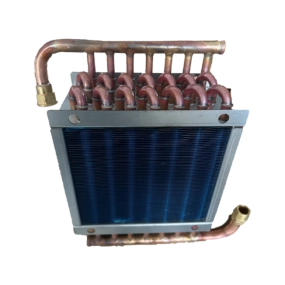- This topic is empty.
-
AuthorPosts
-
24/06/2024 at 14:17 #93412
As a heat exchange equipment widely used in the fields of refrigeration and chemical industry, copper tube aluminum fin condenser has efficient heat exchange performance and good corrosion resistance. However, during the transportation and storage of equipment, appropriate measures must be taken to ensure that its integrity and functionality are not affected. The purpose of this article is to provide recommendations on the transportation and storage of copper tube aluminum fin condensers to reduce the risk of equipment damage and extend its service life.
1. Preparation work before transportation
Cleaning and inspection: Before transportation, the copper tube aluminum fin condenser should be thoroughly cleaned to remove dirt and moisture to avoid rust or other corrosion during long-term transportation. At the same time, conduct a comprehensive inspection to ensure that all parts are secure and not loose or damaged.
Anti-corrosion treatment: Carry out anti-corrosion treatment on the surface of copper tubes and aluminum fins, and use appropriate anti-rust oil or anti-corrosion coating, especially on the surface of aluminum fins, because aluminum is easier to oxidize.
Reasonable packaging: Use sturdy packaging boxes filled with sufficient cushioning materials (such as foam plastics, cardboard, etc.) to ensure that the equipment will not be damaged by shaking or vibration during transportation. For particularly sensitive components, such as pipe joints or flanges, additional protection measures should be considered, such as using shock mounts or straps to reduce shock.
Clear markings: Clearly mark the packaging boxes with instruction labels such as "Fragile" and "Up", and ensure that all transportation documents are complete, including packing lists, equipment instructions, and maintenance manuals, so that they can be shipped promptly after arriving at the destination. Perform installation and commissioning.

2. Points to note during transportation
Choose the appropriate transportation method: Choose the most appropriate transportation method based on the copper tube aluminum fin condenser size, weight, and destination distance. For larger or heavier equipment, it is recommended to use dedicated vehicles for transportation; for international transportation over long distances, the possibility and cost of sea or air transportation may need to be considered.
Ensure dryness and ventilation: During transportation, it is necessary to ensure dryness and ventilation in the cargo hold to prevent corrosion of the condenser surface or internal parts caused by a humid environment. If necessary, use desiccants or dehumidification equipment to control humidity.
Avoid extreme temperature changes: Try to avoid transportation in areas or seasons with large temperature changes. Because copper and aluminum have different thermal expansion coefficients, extreme temperature changes may cause changes in the microstructure of the material and affect equipment performance.
3. Storage conditions and requirements for copper tube aluminum fin condenser
Dry environment: The storage area must be kept dry, and there should be shelves on the ground to avoid direct contact with the ground. Desiccant can be used to absorb moisture from the air and the effectiveness of the desiccant should be checked regularly.
Avoid chemical pollution: The storage location should be away from the erosion of harmful gases or chemical substances to avoid material changes caused by chemical reactions between copper tubes and aluminum fins.
Reasonable arrangement: The storage space should be reasonably planned according to the size and weight of copper tube aluminum fin condensers. Heavier devices should not be stacked too high to avoid deformation of the bottom equipment due to excessive pressure.
4. Maintenance of long-term storage
Regular inspection: Even if it is stored for a long time, the condenser should be inspected regularly, including visual inspection and functional testing. Once signs of rust or other damage are found, they should be dealt with promptly.
Protective coating repair: If the surface protective layer is found to be damaged, it should be repaired immediately and re-coated with anti-rust material to prevent continued corrosion.
Record storage conditions: Record in detail the temperature and humidity changes in the storage environment, as well as the inspection and maintenance of the equipment. This data is very valuable information for the future use and maintenance of the equipment.
In summary, through careful planning and management of the transportation and storage of copper tube aluminum fin condensers, the potential risk of damage to the equipment in these two links can be minimized and the performance and life of the equipment can be guaranteed. Only by strictly implementing these recommendations can we ensure that the condenser has the best working conditions when it arrives at the installation site, thereby providing users with stable and efficient condensation services.
Senjun
Lon@ningbo-senjun.com -
AuthorPosts
- You must be logged in to reply to this topic.
